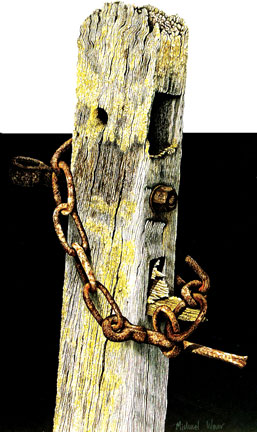The art of painting wood, stones and bricks
by Tissa Hewavitarane
The texture of tree barks, wooden buildings or gates, rocks, stone or
brick walls offer a marvellous opportunity to try out new techniques and
to use the painting and drawing media in ways that you might never have
thought of before.
"Tricks of the trade" such as spattering watercolour or applying it
with sponges, scratching into oil paint or resisting methods are all
perfectly valid painting techniques as long as the result successfully
conveys the correct texture. We look at a variety of these
unconventional descriptive approaches in which the control of form and
details are of equal importance.
Wood
Wood offers one of the greatest ranges of textures of any natural
material. In addition to the huge variety of wood seen out of doors,
from tree barks to weathered and twisted driftwood, there is an almost
infinite number of finishes seen indoors on furniture the result of
sawing, axing, planing and polishing many different types of wood.
 |
|
A painting of wood
showing the correct textures |
You may not want to emphasise the texture of the barks in a
landscape. For example, in a woodland scene painted on the spot you may
only need to suggest it in broad terms, but when a tree is a foreground
feature attention to the texture of the bark can give a focus to the
picture - decayed or rotting wood in the form of gate posts and fences
also make an exciting foreground features in a landscape or can even be
the main centre of interest.
Wood and metal left to rot and rust can be a rich source of subject
matter, as this painting shows. This is a watercolour painting done by
Michael Wan a brilliant artist to depict the correct texture on wood,
metal, stone, brick and on barks.
Technique
The artist has achieved many of the textures by using dry brush
technique. If you look closely at the rocks you can see how the solid
lines peter out as the colour on the brush is gradually used up,
producing a broken dry line that minics those in the wood.
The soft mottled textures of the lichen and the rust have also been
painted with great skill. Here washes and dry brush combines in a
careful building-up process, beginning with the lightest tones and
finishing with darker ones. Many of these have been painted in a
meticulous stippled technique. The soft, muted colours also help to
convey the weather-beaten textures as well as giving an overall unity to
the painting.
The artist has developed details and textures, paying close attention
to the high lights. Notice the thin lines shown on the wood to depict
the decayed structure and rust shown with dotted spots along the chain.
The artist has followed these effects to bring out the correct texture
and producing an almost living impression.
Stones
When you start painting stones it is always a good idea to practise
by trying to master a simple technique. The critic and artist advise us
to begin by going outside and picking up the first stone that you see in
the garden or road.
He maintains that learning how to render the special texture and
character of this stone, one could learn how to draw and paint anything.
As he made clear, the principle of light reflected, light and shadow are
as true for the minutest crack in a pebble as for a large ravine - scale
makes no difference.
In many ways the textures that you find on smaller stones are very
similar to those on a cliff face or in a quarry, and given the right
light and angle can often serve as useful models for larger landscape
features. Once you have thoroughly understood and mastered forms and
textures you can begin to simplify and this is nearly always necessary
when painting large, complex rock surface such as cliffs.
These is no easy recipe for this, but I usually find that trying to
commit a scene to memory is helpful, as it compels you to concentrate on
the main forms and textures, lines and placings, and then proceed to use
the softer grades.
Although most watercolour techniques can be adapted to render the
textures of wood and stone, but there are some methods that can
effectively cut short the more traditional approach. Although many of
the techniques are the result of a methodical approach you may
experiment with less predictable techniques. The texture of the brick
work for example was achieved by smudging the colour with the palm of
the hand and lifting out colours with water.
Frottage
This is the most direct and immediate of methods for creating a wood
or stone texture. The word means 'rubbing' and the methods is exactly
the same as that used for making rubbing of stones and brass plaques in
mainly churches. A sheet of paper is placed on top of the object and
rubber over with a drawing material. The different features of the
underlying texture show up as variations in 'drawing' providing a
complete record of the surface qualities. This method is ideal for wood,
brick and anything with a fairly flat surface. |

